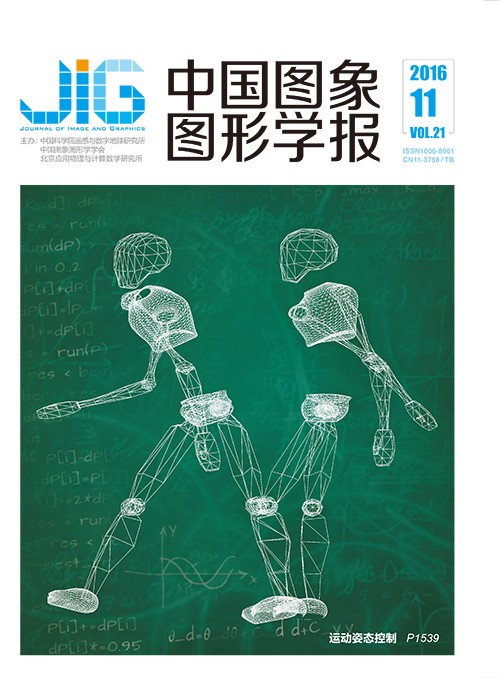
双目系统全视域采样的SVM标定模型分析
杨剑锋1, 蒋刚2, 留沧海2, 李斌3(1.西南科技大学制造科学与工程学院, 绵阳 621010;2.西南科技大学制造过程测试技术教育部重点实验室, 绵阳 621010;3.西南科技大学理学院, 绵阳 621010) 摘 要
目的 为改善摄像机间接标定采样不全、模型表达模糊问题,实现小视场下检测视域完备采样,提出一种基于双目系统全视域采样的支持向量机(SVM)标定方法。方法 该方法利用六角晶格标定板靶点序号可读特点为基础,采集整个双目系统有效视域中检测点的视差坐标、世界坐标并建立完备的样本集。选取SVM对该样本集进行训练,将SVM算法得到的模型参数代入其决策函数中进行求解,获得公式化的标定模型。由于六角晶格标定板的四角和中心分布了5个互为非中心对称的多边形,可在标定板部分区域被采集的情况下获取标定板位姿信息,进而读取采集的各靶点序号。通过上下移动标定板,利用HALCON算子获取图像中各靶点的序号,建立双目视觉系统检测区域的完备样本集。最后,利用SVM算法训练样本获得标定模型,可以明确表达出标定模型的数学形式。结果 与传统采样建立的模型进行对比分析,实验结果表明该方法建立模型的标定误差减小了24.51%,降低了标定模型在传统方法未采样区域的标定误差,证明了该方法的可行性。结论 提出一种基于双目系统全视域采样的支持向量机标定方法,通过非中心对称的多边形确定标定板上靶点的序号,实现双目视觉系统检测视域的完备采样。实验结果表明该方法提高了摄像机间接标定的精度,具有良好的适用性和鲁棒性,适用于小视域内双目视觉系统的间接标定。
关键词
SVM calibration model based on binocular system full vision field sampling
Yang Jianfeng1, Jiang Gang2, Liu Canghai2, Li Bin3(1.School of Manufacturing Science and Engineering, Southwest University of Science and Technology, Mianyang 621010, China;2.Key Laboratory of Testing Technology for Manufacturing Process Ministry of Education, Southwest University of Science and Technology, Mianyang 621010, China;3.School of Science, Southwest University of Science and Technology, Mianyang 621010, China) Abstract
Objective Indirect calibration can build a calibration model and has been used by many academic researchers. For most methods, the detection field of binocular stereo vision system has been regarded as a cuboid space to make the sample set. However, the main problem existing in the method of sample is that the detection field of binocular stereo vision system is conical space. Predicting the label of instance, which is absent in sampling area, is also difficult. The calibration model is usually not a clear mathematical model in these studies. This paper proposes a calibration method by support vector machine (SVM) based on binocular system full vision field sampling to improve the video camera's insufficient and indirect calibration sampling and vague model expression, and realize the complete modal sampling of detection view field in small vision field. Method The sampling method uses the readability of the target number of hexagonal lattice calibration board as the basis, collects parallax coordinates and world coordinates, and establishes complete sample sets in the entire effective vision field of the binocular system. The SVM is selected to train the sample set, and a calibration with mathematical expression is established with model parameters calculated from the SVM algorithm to the decision function. Five mutually non-centrosymmetric polygons are placed at the four corners and center of the hexagonal lattice calibration board. The position information of the calibration board can be obtained with the collected partial region information of the calibration board, and the target number is known. The target number in images is acquired by HALCON operators by moving the calibration plate, and a complete set of samples of detection field is established based on binocular system. Finally, the SVM algorithm is used to train the samples to obtain calibration models that can articulate the mathematical form of a calibration. Result The samples used in this study include 568 targets from all 2 839 samples, and contain ground truths in the form of accurate world coordinates for detected targets. Two kinds of sampling method are adopted in the experiment, namely, traditional sampling method for cuboid space and full vision field sampling method for conical space. Experimental results show that calibrated error was reduced by 24.51% as compared with that of the model established based on traditional sampling method. Thus, the feasibility of the proposed method was supported given that the calibration error of calibration model was reduced in the unsampled region with conventional method. Conclusion A calibration method by SVM based on binocular system full vision field sampling is proposed with non-centrosymmetric polygons to identify the target number on calibration board. The proposed method improves the indirect calibration precision. The method is also feasible, robust, and suitable to indirect calibration based on binocular system in small vision field.
Keywords
binocular system full vision field sampling SVM (support vector machina) indirect calibration calibration model hexagonal lattice calibration board
|



 中国图象图形学报 │ 京ICP备05080539号-4 │ 本系统由
中国图象图形学报 │ 京ICP备05080539号-4 │ 本系统由